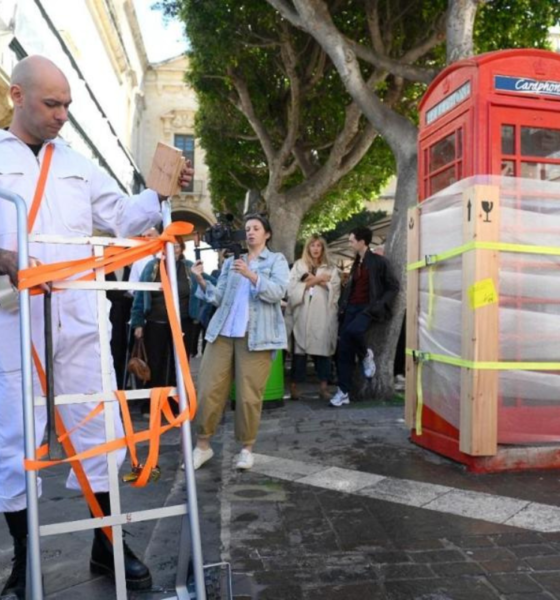Bonnici with the artwork during the installation’s performance. Photo: Matthew Mirabelli
Maltese artist Keit Bonnici has claimed his artwork at the inaugural Maltabiennale.art was “censored” after it was removed without his consent and stored for a month in an undisclosed location.
Bonnici said that his installation, went missing on May 1, and only discovered its whereabouts after the biennale ended on May 31.
Fuq l-Art involved bubble-wrapping and tightly securing one of Valletta’s iconic red telephone boxes. The box was topped with a bright yellow postage sticker bearing the origin “United Kingdom” and a blank section for the destination. The artwork was a commentary on decolonisation and the evolving role of monuments in public spaces.
Speaking to Times of Malta, Bonnici said, “As artists, we rely on exposure for our work. For one-third of the agreed duration, my piece wasn’t shown to the public – which affects my livelihood.”
The artist insisted he had not been informed about the reason for the removal and only retrieved the artwork from Heritage Malta after the biennale ended. “Why was my artwork held in secret storage for a month? Neither I nor the curators knew where it was. I was only allowed to collect it after the biennale was over. Heritage Malta never responded to my questions about this.”
president of the biennale, dismissed the censorship claims as “absurd”.
He explained that Bonnici’s work had been selected, approved, and sponsored for the exhibition. According to Cutajar, the artwork had become “unsightly” due to damage, prompting the organisers to ask Bonnici, via artistic director Sofia Baldi Pighi, to work on the maintenance of the piece.
The artwork after being damaged Photo:Keit Bonnici
“On April 23, we asked Bonnici through the artistic director to carry out maintenance on the artwork that week. Nothing was done. One week later, on April 30, we repeated our request, stating that if repairs were not carried out, the piece would have to be dismantled. Again, nothing happened, and the artwork was removed that evening,” Cutajar told Times of Malta.
The piece was damaged because parts of the bubble wrap were ripped off by members of the public, he said.
Bonnici, however, defended this as part of the artwork’s evolution, saying the public’s interaction with it was integral to the piece.
“It’s a travelling object, and like anything transported, it can get battered. I have no issue with people interacting with the artwork. When an artwork exists in public space, it has the chance to evolve.”
Artistic director Baldi Pighi assumed the role of mediator between Bonnici and the organisation and supported the artist’s stance. She shared her communications with Times of Malta, which showed her disapproval of dismantling the piece.
“Artworks are mechanisms to foster discussion and convey critical thought, and once again, Keit Bonnici’s work proves effective,” she said.
Baldi Pighi emphasised that out of the more than one hundred artworks in the biennale, the ones placed in public spaces have had the most impact.
“Ask any person living in Malta, whether art professional or not, and the works they will remember are those in public spaces,” she added.
Cutajar, however, criticised the timing of Bonnici’s public claims, questioning why the artist had waited over four months before speaking out. “I’m quite sure that had Mr Bonnici been censored in any way, he would have cried foul immediately, without waiting more than four months and claiming it in a post advertising the artwork for sale or exhibition.”
Label on the artwork Photo: Matthew Mirabelli
Bonnici said he had been working on resolving the issue privately for months, with support from the biennale curatorial team and the Malta Entertainment Industry and Arts Association. Due to financial and legal concerns, however, he had chosen not to go public until recently.
“I tried to speak earlier, but my hands were tied. We were still waiting for material reimbursement from Heritage Malta,” he explained.
MEIA has since supported Bonnici, claiming that his case was not an isolated incident.
“We received several concerns from other participants and MEIA members about organisational and ethical issues,” the association said.
It added that discussions with Cutajar and Heritage Malta CEO Noel Zammit had revealed “a troubling lack of understanding of contemporary art practices, a dismissive attitude toward concerns, and an unwillingness to acknowledge any wrongdoing”.
Bonnici said he was not the only artist to claim censorship at the biennale. Italian artist Salso reported that her pro-choice artwork Unborn Celebration was censored during the event.

